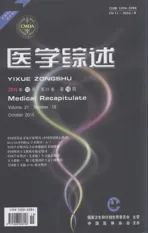加温湿化高流量鼻导管吸氧治疗新生儿疾病的研究进展
2015-12-09赵玉祥综述审校
赵玉祥(综述),武 荣(审校)
(扬州大学医学院附属淮安市妇幼保健院新生儿科,江苏淮安223002)
新生儿无创呼吸支持包括经鼻间隙正压通气(nasal intermittent positive pressure ventilation,NIPPV)、经鼻持续正压通气(nasal continuous positive airway pressure,NCPAP)、头罩或面罩吸氧、鼻导管吸氧等。NCPAP或NIPPV容易造成表皮脱落、鼻中隔损伤,治疗时患儿耐受性差,不适感强,镇静剂用量增加,不便于护理。低流量鼻导管吸氧或头罩吸氧虽然患儿较为舒适、依从性好,但气体未经过加温湿化,不能精确调节氧浓度,对患儿肺功能的辅助作用较小。与传统面罩吸氧相比,加温湿化高流量鼻导管吸氧(humidified high flow nasal cannula,HHFNC)更可以改善急性呼吸衰竭患者的氧合,降低患者的呼吸频率[1]。近年国外有调查表明[2],美国77%的医院在使用HHFNC,澳大利亚和新西兰应用HHFNC的医疗单位高达63%。但在国内新生儿重症监护病房中HHFNC应用不多。现对HHFNC治疗新生儿疾病的研究进展进行综述。
1 HHFNC吸氧流量和所需设备
1.1 HHFNC吸氧流量 对于鼻导管吸氧的流量临床上一直有严格的限制。规定鼻导管吸氧的流量0.5~2 L/min。以往不推荐新生儿鼻导管吸氧的氧流量>2 L/min,由于未经加温的高流速气体很难在湿化器内被充分的湿化,所以即使是湿化的气体也不推荐流量超过4 L/min。HHFNC是近年应用于临床治疗呼吸衰竭等疾病的一种呼吸支持方式[3-4]。HHFNC是指在细小、狭长的导管内输送流量>1 L/min的加温湿化氧气或空氧混合气体。一般流量在2~8 L/min。HHFNC可输送高浓度的氧气及提供呼气末正压。
1.2 HHFNC所需设备 HHFNC目前有Vapotherm2000i和Fisher&Paykel公司生产的两种设备供选择。其中在临床上应用较多的是 Fisher&Paykel,其由空氧混合仪和专业温化湿化器组成。Fisher&Paykel公司提供的湿化器鼻导管型号为CE0120,鼻导管外径 0.2 cm。Collins 等[5]研究认为,在流量2~6 L/min时两种湿化装置产生相似的咽部压力。而Hasan等[6]研究表明,在气体流速≤8L/min时,Fisher&Paykel所产生的压力高于Vapotherm2000i;而在气体流速>8 L/min 时,由于 Fisher&Paykel的压力释放特点,其所产生的压力低于Vapotherm2000i装置。
2 HHFNC治疗新生儿疾病的可能机制
HHFNC通过无需密封的特制鼻塞导管直接经鼻输入加温湿化的氧气或空氧混合气体,氧流量一般为2~8 L/min。其所产生的压力与患儿体质量呈负相关,即患儿体质量越轻,所产生的压力越大。HHFNC可减少NCPAP等所致的分泌物聚积、气道变冷和水分流失等情况发生,同时可减轻或避免对患儿鼻部的刺激,从而减轻对鼻中隔的损伤,HHFNC确实可产生一定的气道正压[7]。HHFNC还可以减少死腔、降低鼻咽阻力、降低呼吸功、利于肺复张、改善黏膜灌注以及刺激呼吸中枢[8-9]。HHFNC能有效迅速地改善氧合、加快 CO2排出,其原理为:①HHFNC将外界气体加温湿化,达最适人体温度(37℃)和湿度,有利于气道黏膜纤毛的运动和气道分泌物的顺利排出;②HHFNC提供大量新鲜的含氧气体冲洗鼻咽部生理死腔,有利于促进肺泡O2、CO2交换;③HHFNC可提供低水平的持续气道正压,其所提供的气体流速加快,即大于或等于患者主动吸气的最大吸气流速,从而使吸气阻力和患儿呼吸功大大降低;④HHFNC的主动温湿化可使机体对外界气体进行温湿化所消耗的热量减少。
3 HHFNC的适用范围
HHFNC可以产生低水平的呼气末正压通气,改善患儿的氧合和呼吸力学,可以替代其他无创通气方法,为呼吸衰竭患者的一种常用治疗手段[10-11]。其应用在国外报道较多[12-13]。HHFNC用于儿童患者毛细支气管炎的辅助治疗已有较多的文献报道[14-16]。因为其使用方便、患者耐受性好等优点广泛应用于婴儿和早产儿[17-18],急性呼吸功能不全患儿早期应用可以减少气管插管机械通气的需要[19]。HHFNC在新生儿主要应用于以下几个方面。
3.1 早产儿呼吸暂停 早产儿呼吸中枢及呼吸器官等发育均不成熟,所以容易发生呼吸暂停,出生后建立规律的呼吸节律是许多早产儿面临的主要问题。呼吸暂停早期频繁的低氧血症主要与早产儿肺容量低有关,而肺容量在呼吸暂停过程中降低得更多。HHFNC的作用机制就是提供一个类似于NCPAP的气道正压,使其更有助于肺容量的恢复[20]。临床研究表明,极低出生体质量儿在使用 HHFNC治疗时,产生的气道正压比体质量相对偏大的低出生体质量早产儿更大,故对肺容量的恢复效果更好。
3.2 早产儿呼吸窘迫综合征 一项随机对照试验表明,HHFNC和NIPPV用于早产儿呼吸窘迫综合征初始治疗在避免气管插管机械通气方面一样有效[21]。也有研究认为[22],HHFNC可以减少呼吸窘迫综合征早产儿NCPAP的使用,并不增加总的无创呼吸支持时间;HHFNC与NCPAP相比,在取得相同治疗效果的前提下,前者不增加鼻外伤的风险,具有更高的性价比。
3.3 拔管后辅助呼吸支持 对28周以上的呼吸功能不全早产儿而言,HHFNC和NCPAP作为拔管后或初始呼吸支持治疗,两者具有相似的临床疗效和安全性[23]。Collins等[24]将胎龄<32周的气管插管机械通气早产儿按拔管后无创通气方式随机分成HHFNC治疗组和NCPAP治疗组,观察两组患儿生后第1周需重新插管比例,结果表明两组的差异无统计学意义,HHFNC治疗组鼻损伤的发生率明显偏低。
4 HHFNC的优缺点
Hough等[25]的一项临床调查表明,62%的医师把HHFNC用来提供气道正压通气,91%的医师认为HHFNC能够减少鼻部损伤,86%的医师认为 HHFNC操作简单、方便护理,84%的医师认为HHFNC能够提高婴儿的耐受性。HHFNC通过细短的双腔鼻导管输送高流量的加温加湿气体,其鼻塞是针对不同体质量患儿配置不同型号专用鼻塞,无需密闭,更容易固定和护理,患者依从性更好,避免了对患儿鼻中隔造成的明显压迫,减少了鼻损伤的发生。
呼吸衰竭患者应用HHFNC治疗可显著降低其心率和呼吸频率,改善患者的经皮氧饱和度[26-27]。HHFNC通过空氧混合仪提供的空氧混合气体,吸入氧浓度可精确调控而不随患者呼吸状态改变,从而减少早产儿视网膜病和支气管肺发育不良的发生。
5 展望
HHFNC可以治疗早产儿呼吸暂停、轻度呼吸窘迫综合征、呼吸衰竭等疾病,但在应用HHFNC之前,需做好以下几点:①HHFNC所提供的呼气末正压容易变化、相对不可预测,而且不可调整,对肺功能的影响需谨慎监测;②尽快明确HHFNC治疗的适应证,预测或处理HHFNC治疗可能出现的并发症;③HHFNC应用的临床证据相当有限,HHFNC的使用目前仍没有明确的规范或指南,基本是出于个人的爱好,需要进行大规模的临床多中心病例对照研究,尽早制订出HHFNC治疗的规范与临床指南。
[1]Roca O,Riera J,Torres F,et al.High-flow oxygen therapy in acute respiratory failure[J].Respir Care,2010,5(4):408-413.
[2]Ojha S,Gridley E,Dorling J.Use of heated humidified high-flow nasal cannula oxygen in neonates:a UK wide survey[J].Acta Paediatr,2013,102(3):249-253.
[3]Wilkinson D,Andersen C,O'Donnell CP,et al.High flow nasal cannula for respiratory support in preterm infants[J/CD].Cochrane Database Syst Rev,2011(5):CD006405.
[4]Lenglet H,Sztrymf B,Leroy C,et al.Humidified high flow nasal oxygen during respiratory failure in the emergency department:feasibility and efficacy[J].Respir Care,2012,57(11):1873-1878.
[5]Collins CL,Holberton JR,König K.Comparison of the pharyngeal pressure provided by two heated,humidified high-flow nasal cannulae devices in premature infants[J].J Paediatr Child Health,2013,49(7):554-556.
[6]Hasan RA,Habib RH.Effects of flow rate and airleak at the nares and mouth opening on positive distending pressure delivery using commercially available high-flow nasal cannula systems:a lung model study[J].Pediatr Crit Care Med,2011,12(1):e29-33.
[7]Ritchie JE,Williams AB,Gerard C,et al.Evaluation of a humidified nasal high-flow oxygen system,using oxygraphy,capnography and measurement of upper airway pressures[J].Anaesth Intensive Care,2011,39(6):1103-1110.
[8]Rubin S,Ghuman A,Deakers T,et al.Effort of breathing in children receiving high-flow nasal cannula[J].Pediatr Crit Care Med,2014,15(1):1-6.
[9]Gotera C,Díaz Lobato S,Pinto T,et al.Clinical evidence on high flow oxygen therapy and active humidification in adults[J].Rev Port Pneumol,2013,19(5):217-227.
[10]Chikata Y,Izawa M,Okuda N,et al.Humidification performance of two high-flow nasal cannula devices:a bench study[J].Respir Care,2014,59(8):1186-1190.
[11]Peters SG,Holets SR,Gay PC.High-flow nasal cannula therapy in do-not-intubate patients with hypoxemic respiratory distress[J].Respir Care,2013,58(4):597-600.
[12]Díaz-Lobato S,Folgado MA,Chapa A,Mayoralas Alises S.Efficacy of high-flow oxygen by nasal cannula with active humidification in a patient with acute respiratory failure of neuromuscular origin[J].Respir Care,2013,58(12):e164-167.
[13]Ricard JD.High flow nasal oxygen in acute respiratory failure[J].Minerva Anestesiol,2012,78(7):836-841.
[14]Metge P,Grimaldi C,Hassid S,et al.Comparison of a high-flow humidified nasal cannula to nasal continuous positive airway pressure in children with acute bronchiolitis:experience in a pediatric intensive care unit[J].Eur J Pediatr,2014,173(7):953-958.
[15]Bueno Campaña M,Olivares Ortiz J,Notario Muñoz C,et al.High flow therapy versus hypertonic saline in bronchiolitis:randomised controlled trial[J].Arch Dis Child,2014,99(6):511-515.
[16]Beggs S,Wong ZH,Kaul S,et al.High-flow nasal cannula therapy for infants with bronchiolitis[J/CD].Cochrane Database Syst Rev,2014,1:CD009609.
[17]Haq I,Gopalakaje S,Fenton AC,et al.The evidence for high flow nasal cannula devices in infants[J].Paediatr Respir Rev,2014,15(2):124-134.
[18]Kim IK,Phrampus E,Sikes K,et al.Helium-oxygen therapy for infants with bronchiolitis:a randomized controlled trial[J].Arch Pediatr Adolesc Med,2011,165(12):1115-1122.
[19]Wing R,James C,Maranda LS,et al.Use of high-flow nasal cannula support in the emergency department reduces the need for intubation in pediatric acute respiratory insufficiency[J].Pediatr Emerg Care,2012,28(11):1117-1123.
[20]Corley A,Caruana LR,Barnett AG,et al.Oxygen delivery through high-flow nasal cannulae increase end-expiratory lung volume and reduce respiratory rate in post-cardiac surgical patients[J].Br J Anaesth,2011,107(6):998-1004.
[21]Kugelman A,Riskin A,Said W,et al.A randomized pilot study comparing heated humidified high-flow nasal cannulae with NIPPV for RDS[J].Pediatr Pulmonol,2014[Epub ahead of print].
[22]Fernandez-Alvarez JR,Gandhi RS,Amess P,et al.Heated humidified high-flow nasal cannula versus low-flow nasal cannula as weaning mode from nasal CPAP in infants ≤28 weeks of gestation[J].Eur J Pediatr,2014,173(1):93-98.
[23]Yoder BA,Stoddard RA,Li M,et al.Heated,humidified high-flow nasal cannula versus nasal CPAP for respiratory support in neonates[J].Pediatrics,2013,131(5):e1482-1490.
[24]Collins CL,Holberton JR,Barfield C,et al.A randomized controlled trial to compare heated humidified high-flow nasal cannulae with nasal continuous positive airway pressure postextubation in premature infants[J].J Pediatr,2013,162(5):949-954.e1.
[25]Hough JL,Shearman AD,Jardine LA,et al.Humidified high flow nasal cannulae:current practice in Australasian nurseries,a survey[J].J Paediatr Child Health,2012,48(2):106-113.
[26]Sztrymf B,Messika J,Bertrand F,et al.Beneficial effects of humidified high flow nasal oxygen in critical care patients:a prospective pilot study[J].Intensive Care Med,2011,37(11):1780-1786.
[27]Klingenberg C,Pettersen M,Hansen EA,et al.Patient comfort during treatment with heated humidified high flow nasal cannulae versus nasal continuous positive airway pressure:a randomised crossover trial[J].Arch Dis Child Fetal Neonatal Ed,2014,99(2):F134-137.
